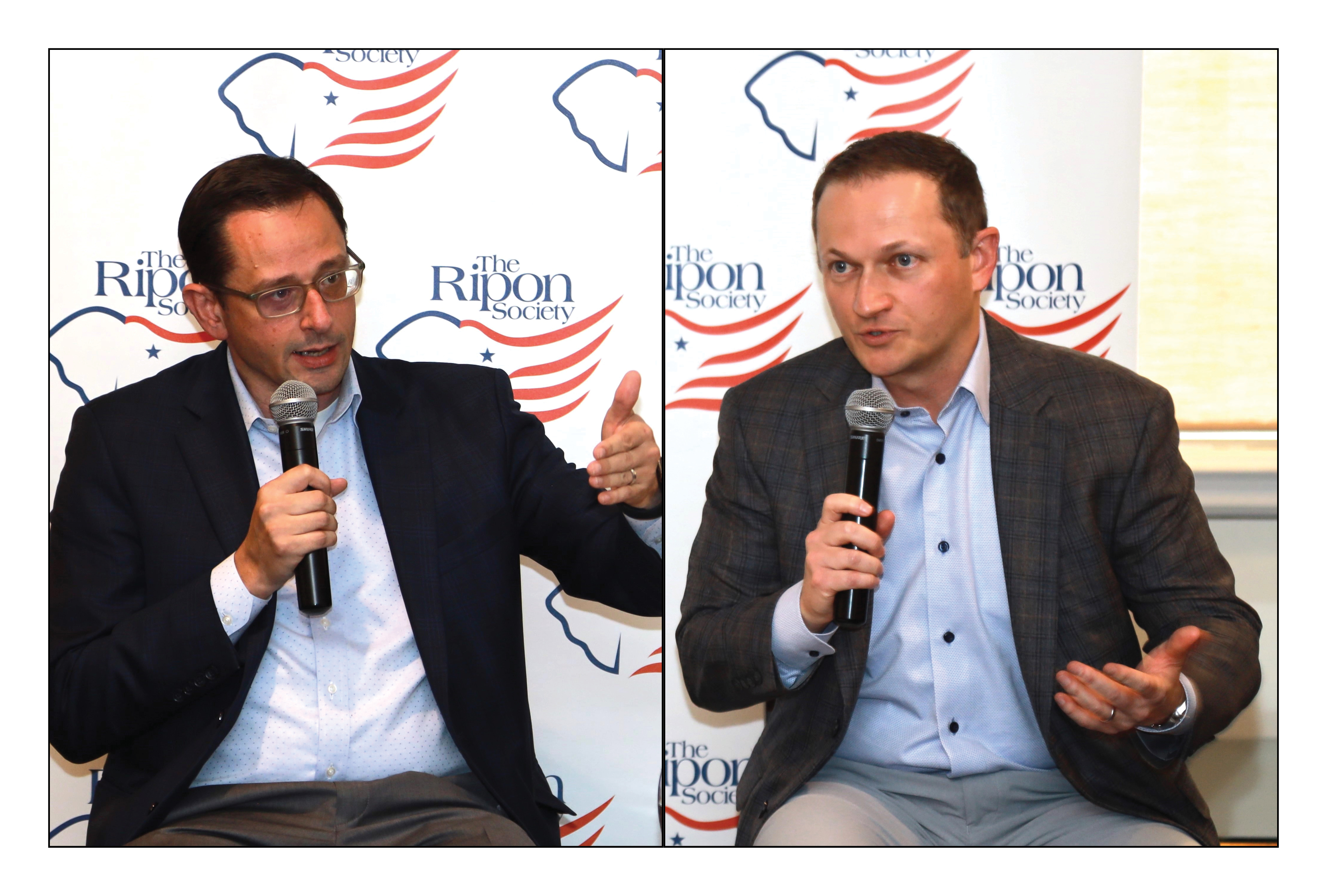
NRSC & NRCC Executive Directors Evaluate 2024 Election Cycle
WASHINGTON, DC – For their final political briefing before Election Day, National Republican Senatorial Committee (NRSC) Executive Director Jason Thielman and National Republican Congressional Committee (NRCC) Executive Director Chris Winkelman discussed the dynamics of the 2024 House and Senate election cycles at a lunch meeting of The Ripon Society this past Thursday.
“I am confident we will retake the majority in the United States Senate,” Thielman stated in his opening remarks. “The Chairman and I made one promise when we walked into that building – we will win the state of Montana, come hell or high water. We are going to win the state of West Virginia. I feel very confident about Ohio as well. After that, it gets certainly much more difficult to predict.”
Thielman, who has been a top aide to the current NRSC Chairman Senator Steve Daines (R-MT) since 2012, spearheads efforts to offer essential support and assistance to both current and potential Republican U.S. Senate candidates through his role at the NRSC. Following the 2022 elections, he shared how he and the Chairman have designed their strategy to optimize the 2024 cycle, particularly in West Virginia, Montana, and Ohio.
“Job number one was to get Governor Jim Justice into the Senate race in West Virginia. It was our belief that if Justice got into the race, Joe Manchin would not run for reelection, and that’s exactly what happened.”
Thielman then shared how the NRSC was able to avoid a messy primary in Montana which resulted in combat veteran Tim Sheehy challenging incumbent John Tester (D-MT).
“Fast forward to Montana,” he continued, “Trump endorsed Tim Sheehy. We got a Rule 11 from the state party and cleared the primary field, and we’re now in a position where we’re consistently polling just outside the margin of error.”
“Then we move to Ohio,” he continued, “and we see the exact same polling pattern for Bernie Moreno as we did for JD Vance – post-primary down double digits closing to within single and now moving to a slight two-to-three-point lead in our internal polling. And, of course, JD Vance went on to win by six points. We feel very comfortable with the trajectory of that race.”
Looking West, Thielman analyzed the race of Senate candidate Sam Brown in Nevada.
“Sam’s numbers are starting to converge much more closely with the President’s. With the early vote and the mail-in ballots in the state of Nevada – we are at a place we have not been as Republicans in that state where the Democrat’s firewall in Las Vegas is not what it’s ever been before the rural votes are in. We are swamping the vote with the early vote there. Everything we can see suggests that we are on track for a very strong turnout and a strong victory.”
Thielman then discussed the importance of the correlation between the race for control of the Senate and the Oval Office.
“68 out of 69 Senate races in 2016 and 2020 mirrored the result of the presidential race.”
“Unless we see someone really break out here, it just could not be closer in these states. A quarter or a half a point might easily separate the performance between a presidential candidate and Senate candidate, or a House candidate down the ballot.”
Winkelman, who currently serves under NRCC Chairman Rep. Richard Hudson (NC-09), then shared his perspective on the state of the 35 races that will determine control of the U.S. House of Representatives.
“We have different maps for sure, both very tight,” he stated. “But structurally and strategically, I think we both agreed on day one of last year that we had some industry-wide problems we had to address. They included what Jason talked about — candidate recruitment. We cannot have un-electable candidates win primaries. The map is far too tight for that to happen. Both of us committed to and have worked very, very hard at recruiting effectively to avoid that outcome.”
Winkelman then touched on the House map this year and how it compares to the election cycle — and redistricting cycle — four years ago.
“Prior to 2020 — the last round of redistricting —there were over 50 seats across the country that were won or lost on the presidential level by five points or less,” he noted. “Right now — after 2020 redistricting — there are 35. That is not a huge swath of seats. Thirty-five seats comprise mostly the competitive nature of this majority. The battleground was identified from Day One — which meant that in January of 2023, I could look across to the DCCC and they could look across to us and we could probably have a similar theory of what races we were going into.”
“I have a slide that compares the generic ballot in September of 2020 versus September of 2024. And the whole point is that the environment is better today than it was in 2020. Trump lost in 2020 by 45,000 votes in a dozen counties across the country. That’s how close it was. Then I updated that September 2020 generic ballot number to October 15th, 2020. And it was going the wrong way in every single swing state. In some swing states, the Democrats were gaining six points on that generic ballot. So, I looked up what happened in October of 2020. Covid was happening. Donald Trump went to Walter Reed.
“This is a very different time. We are now in an even better environment in October of 2024 than we were in October of 2020. Our generic ballot and all of the swing states are moving incrementally in our direction. All of those things, along with my district-level polling, tells me things are closing the right way. I give us the upper hand in keeping and growing the majority.”
To view Thielman and Winkelman’s remarks to The Ripon Society Thursday morning, please click the link below:
The Ripon Society is a public policy organization that was founded in 1962 and takes its name from the town where the Republican Party was born in 1854 – Ripon, Wisconsin. One of the main goals of The Ripon Society is to promote the ideas and principles that have made America great and contributed to the GOP’s success. These ideas include keeping our nation secure, keeping taxes low and having a federal government that is smaller, smarter and more accountable to the people.



